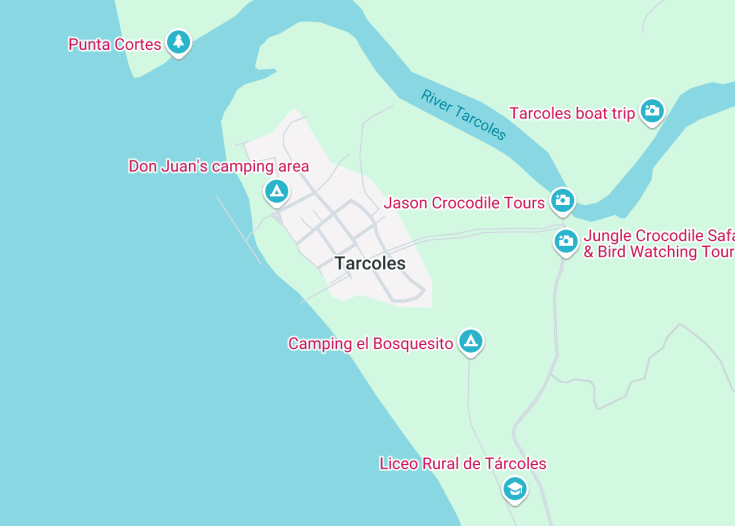Nestled on the central Pacific coast of Costa Rica, Tarcoles is renowned for its rich biodiversity and stunning natural landscapes. This quaint village is especially famous for the Tarcoles River, home to one of the world’s largest populations of American crocodiles.
Visitors can experience thrilling crocodile safaris, explore mangrove wetlands, and indulge in bird watching, capturing sights of rare species. Tarcoles also serves as a gateway to the Carara National Park, making it a pivotal spot for eco-tourists and nature lovers seeking a serene retreat amidst verdant surroundings.
When visiting Tarcoles, ensure to take a guided river tour early in the morning for cooler temperatures and more active wildlife sightings.
Planning a trip to Tarcoles? Don’t forget to bring binoculars to enhance your bird watching experience, as the area is a haven for many exotic species.
Top things to do & see in Tarcoles
Select the following sights and activities to discover best tickets and tours available in Tarcoles.
Tarcoles: A Slice of Paradise by the Crocodile Waters
| Country | Costa Rica |
| Time in Tarcoles | GMT-6 |
| Language spoken | Spanish |
| Population | Approximately 4,600 (based on local government data) |
| Currency | Costa Rican Colón (₡, CRC) |
| Airports |
|
Tarcoles, a serene village in the Puntarenas province of Costa Rica, is renowned for its breathtaking landscapes and abundant wildlife, particularly its crocodiles along the river Tarcoles. This coastal gem stands out for its rich biodiversity and is a prime spot for eco-tourism with activities ranging from bird watching to river tours showcasing its famous crocodile inhabitants.
Significantly less crowded than its more commercialized counterparts, Tarcoles offers a more intimate experience with nature. An historical heart of Chorotega and later colonial influences, Tarcoles tells the hushed tales of Costa Rica’s past through its tranquil scenery and enduring cultural practices.
Where is Tarcoles?
Tarcoles is located within the Puntarenas province on the Pacific coast of Costa Rica.
Distances:
| Route | Distance by car | Time by car |
|---|---|---|
| San José to Tarcoles | 60 miles (97 km) | 1 hour 30 min |
| Jaco to Tarcoles | 14 miles (23 km) | 20 min |
| Monteverde to Tarcoles | 92 miles (148 km) | 3 hours |
What is Tarcoles famous for?
Tarcoles is celebrated for its spectacular sighting of large crocodiles, a secluded beach experience, unspoiled nature trails, and as a pivotal birdwatching locale within Central America.
History
Pre-Columbian and Colonial Times (Before 1502 – Late 1700s)
The area now known as Tarcoles in Costa Rica has a rich history that stretches back to its early inhabitants, the indigenous tribes, who thrived along the fertile river banks, fishing and cultivating the land. With the arrival of the Spanish in the early 16th century, the region saw significant changes. Yet, despite these changes, little is known about the specific developments in Tarcoles during the colonial era as it remained a largely peripheral area to the main colonial activities.
19th Century – Early Development (1800s – Early 1900s)
Following Costa Rica’s independence from Spain in 1821, Tarcoles began to slowly develop. The late 19th and early 20th centuries marked a period of gradual growth, with the establishment of small farming communities. The cultivation of crops such as bananas and the raising of livestock became prevalent, shaping the economic landscape of the region.
Mid to Late 20th Century – Economic Shifts (1950s – 1990s)
The mid-20th century brought significant economic changes to Tarcoles, most notably through the rise of tourism. The region’s natural beauty, particularly its proximity to the Carara National Park, began attracting visitors from around the world. This shift saw a gradual decrease in traditional farming and an increase in services and amenities catering to tourists.
21st Century – Conservation and Tourism (2000 – Present)
In recent decades, Tarcoles has focused heavily on conservation efforts, particularly concerning its rich biodiversity and the famous Tarcoles River, home to one of the largest populations of American crocodiles. Eco-tourism has become a significant aspect of the local economy, with efforts being made to preserve the natural habitat while promoting responsible travel and bird watching activities. The community has also strengthened, building better infrastructure to support the growing tourism sector.
Visit Tarcoles
Things to Explore and Activities in Tarcoles
Visitors to Tarcoles are treated to a plethora of activities and sights that highlight the natural and cultural heritage of the region. Prominent among these is the Tarcoles River, known for its crocodile tours where visitors can safely observe these majestic reptiles in their natural habitat.
The proximity to Carara National Park offers ample opportunities for bird watching, with the park being a sanctuary for the scarlet macaw. Hiking and guided eco-tours provide deeper insight into the diverse flora and fauna.
- Crocodile watching on the Tarcoles River
- Bird watching in Carara National Park
- Guided eco-tours and hiking opportunities
- Visits to local farms to experience traditional agriculture
Annual Events in Tarcoles
Throughout the year, Tarcoles hosts a variety of events that celebrate both its natural and cultural riches. The Tarcoles River Festival, held annually in the dry season (December – April), exemplifies local customs and conservational efforts with festivities that include music, dance, and educational activities. These events provide a great time for visitors to engage with the community and enjoy the local culture.
Best time to visit Tarcoles
The best time to visit Tarcoles is during the dry season, from December to April. This period provides the most pleasant weather for exploring the outdoors, especially for river tours and park visits, with minimal rainfall and lush scenery.
Is Tarcoles worth visiting?
Tarcoles is undoubtedly worth visiting for those intrigued by natural landscapes and wildlife. The unique opportunity to observe American crocodiles in their natural environment, combined with the accessible and rich biodiversity of the nearby Carara National Park, makes Tarcoles a distinctive destination within Costa Rica.
The blend of natural beauty, wildlife exposure, and cultural experiences provides a compelling reason for travel enthusiasts to explore this fascinating area.









